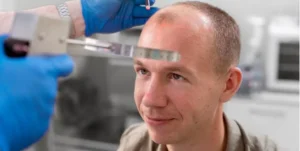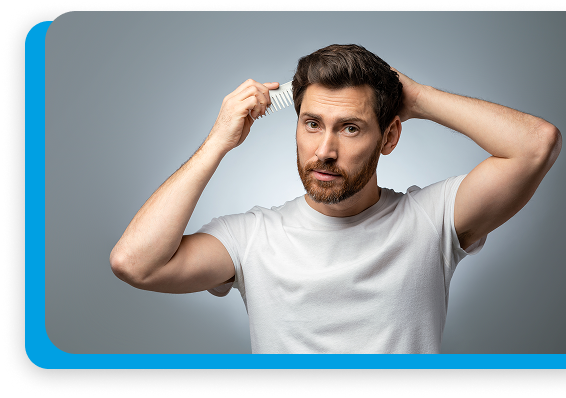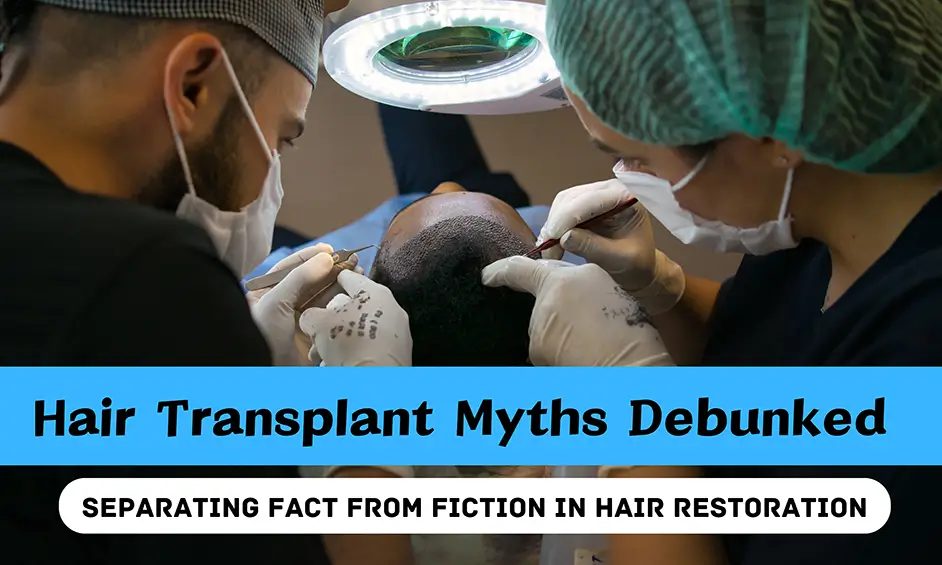Introduction
Many myths surround hair transplants—some as persistent as the hair loss they aim to treat! I’ve encountered numerous patients whose hesitations stem from misinformation, and it’s time to address these. With over two decades in dermatology and hair restoration, I want to separate fact from fiction, helping you make informed decisions with a clearer understanding of the truth behind hair restoration myths.
Key Takeaways
- Common Misconceptions in Hair Restoration: Clear up the common myths so you can have a realistic understanding.
- Myth vs. Fact on Transplant Results: Learn what actually happens with hair transplant results.
- Realities of FUT, FUE, DHI, MHI Techniques: Insights into what modern techniques can truly achieve.
- Who Benefits from Hair Transplants: Discover the truth for both men and women.
Table of Contents
- Common Myths Surrounding Hair Transplants
- Truth Behind Popular Hair Transplant Techniques
- Who Can Benefit from Hair Restoration?
- Debunking Misconceptions About Results and Recovery
- FAQs
- Conclusion: Understanding Hair Transplant Truths
Common Myths Surrounding Hair Transplants

If you’re considering a hair transplant, it’s natural to have questions—and sometimes concerns—based on things you might have heard. There’s a lot of information floating around about hair transplants, and unfortunately, some of it is misleading. Let’s go over a few of the most common myths so you can approach this decision with clarity and confidence.
Myth 1: Only Men Benefit from Hair Transplants
Reality: Hair transplants are absolutely not exclusive to men. While men are more likely to experience male pattern baldness due to genetics, women often struggle with hair loss or thinning as well. Causes in women can range from hormonal changes (like pregnancy, menopause, or thyroid imbalances) to genetics and stress. Hair transplants can be just as transformative for women, who sometimes experience diffuse thinning (a general thinning across the scalp) rather than a defined bald spot. Techniques can be tailored specifically for women to enhance hair density or restore a more defined hairline.
Example: A female patient in her 40s might have thinning hair at the front of her scalp, which can be incredibly distressing. After a tailored hair transplant to increase density in those areas, many women report feeling rejuvenated and more confident in their appearance. The joy of being able to style their hair without worrying about thinning spots is a huge boost.
Myth 2: Hair Transplants Look Unnatural
Reality: This is an outdated notion, likely stemming from the early days of hair transplants when techniques were less advanced. Older methods sometimes created a “plugged” look, where transplanted hair would grow in clusters that didn’t blend well with natural hair. Fortunately, today’s techniques—such as Follicular Unit Extraction (FUE) and Follicular Unit Transplantation (FUT), Direct Hair Implantation (DHI) and Modified Hair Implantation (MHI)—allow for incredibly natural results. Each hair follicle is carefully placed to match the flow and density of your existing hair, ensuring a seamless transition between transplanted and natural hair.
Example: I had a patient who was initially hesitant because he was worried his hairline would look “too perfect” and artificial. But after his MHI procedure, he was thrilled with how naturally the transplanted hair blended with his original hair. The result looked so authentic that his friends didn’t even realize he’d had the procedure—they just commented on how great his hair looked!
Myth 3: Hair Transplants Are Extremely Painful
Reality: Many people hear “surgery” and immediately think of pain. But in reality, hair transplants are very manageable in terms of discomfort. With local anesthesia, patients usually feel little to no pain during the procedure itself. Post-surgery, most experience mild soreness, which can easily be managed with over-the-counter pain relievers. Advances in anesthesia and technique have made hair transplants smoother and far less daunting than they might seem.
Example: A common fear is that the recovery will be long and uncomfortable, but most patients are pleasantly surprised. One patient told me he expected to be in pain for days, but he only felt a little soreness for a day or two. He even went back to work sooner than expected, which helped ease his anxiety about the procedure.
Understanding these myths and the reality behind hair transplants can make a world of difference in your decision-making. Hair transplants are highly customizable, safe, and—thanks to modern methods—capable of providing incredibly natural results with minimal discomfort. Consulting with a skilled professional can help clarify any concerns and open the door to a renewed sense of confidence.
Truth Behind Popular Hair Transplant Techniques

The Solution: Understanding Hair Transplant Techniques – FUE, FUT, DHI, MHI, and MHI+ for Lasting Hair Restoration
Modern hair transplant techniques have advanced significantly, offering permanent, natural-looking results tailored to individual needs. Let’s explore the unique characteristics of each method and understand how they fit different hair loss patterns.
Follicular Unit Extraction (FUE)
Technique: FUE, or Follicular Unit Extraction, involves extracting individual hair follicles from the donor area (usually the back of the scalp) with a specialized tool. This minimally invasive approach leaves small dot-like scars that are often hidden within existing hair, making it ideal for people who prefer shorter hairstyles or are concerned about visible scarring.
Results: FUE provides a highly natural look due to the precise placement of individual follicles. The technique ensures that transplanted hair blends seamlessly with natural hair, creating soft, realistic results. Additionally, FUE generally has a shorter recovery time, allowing patients to resume daily activities more quickly. Learn more about FUE.
Follicular Unit Transplantation (FUT)
Technique: Known as the strip method, FUT involves removing a thin strip of scalp from the donor area. This strip is divided into individual grafts, which are then implanted in thinning or balding areas. While FUT leaves a linear scar in the donor area, it’s often covered by surrounding hair and is usually only visible if the hair is very short.
Results: FUT is beneficial for patients experiencing significant hair loss who seek extensive coverage in a single session. The strip method allows for a higher number of grafts to be transplanted at once, making it a suitable option for individuals looking for fuller coverage with fewer sessions. Discover more about FUT.
Direct Hair Implantation (DHI)
Technique: DHI, or Direct Hair Implantation, takes FUE a step further by using a specialized tool to implant hair follicles directly into the scalp without creating incisions beforehand. This approach allows for greater precision, better control over the angle of growth, and faster recovery times.
Results: DHI is ideal for those looking for a highly controlled, natural-looking result with minimal downtime. The direct implantation method enhances the precision of each follicle’s placement, contributing to a denser and more aesthetically pleasing outcome. Learn more about DHI.
Modified Hair Implantation (MHI) and MHI+
Technique: MHI which is a technique one step ahead of DHI, is refined by me with a focus on precision , offers exceptional control over the depth, angle, and direction of each hair follicle, resulting in an almost bloodless process. This technique is particularly suited for achieving high-density hairlines and maximum coverage with a natural appearance and improved graft survival resulting in high success rate. MHI+ takes this technique further by integrating advanced growth factors such as PRP (Platelet-Rich Plasma) and VThreads, which accelerate healing and promote the growth of thicker, healthier hair.
Results: MHI and MHI+ are perfect for individuals seeking a high-density, long-lasting outcome. The inclusion of growth factors in MHI+ supports faster recovery and enhances the overall quality and density of the transplanted hair, making it ideal for advanced hair loss cases. Explore MHI/MHI+.
Choosing the Right Technique
Each hair transplant method has its own strengths, tailored to varying degrees of hair loss, hair types, and aesthetic goals. FUE is optimal for those desiring minimal scarring and a quick recovery, while FUT offers extensive coverage for patients with more significant hair loss. DHI brings greater control and precision, while MHI and MHI+ provide high-density results with the added benefit of growth factor enhancements.
Understanding the Long-Term Effects of Hair Transplants
A common misconception is that hair transplants halt all future hair loss. While DHT-resistant follicles are used in transplants—meaning they are less likely to fall out—untreated areas of the scalp may still experience thinning over time. Transplanted hair is generally permanent, but it’s essential to care for your natural hair for an even, full look.
To support your hair health and reduce the likelihood of future hair loss, consider:
- Supplements: Nutritional supplements like biotin or zinc can strengthen hair.
- Medications: Options like minoxidil and finasteride may help slow hair loss progression.
- Lifestyle Choices: Maintaining a balanced diet, staying hydrated, and managing stress are vital for overall hair health.
Understanding these differences and consulting with a qualified specialist will help determine the best technique for your needs, setting realistic expectations for optimal and lasting results.
Who Can Benefit from Hair Restoration?

Hair Restoration: It’s Not Limited by Age or Gender Hair transplants aren’t exclusive to one age group or gender. Hair restoration is accessible to anyone experiencing thinning or hair loss, regardless of age or gender. Let’s explore how people of various backgrounds can benefit from this transformative option.
Age and Hair Transplants
Age Limits: While younger patients are often good candidates, hair transplants are equally effective for older individuals. Patients in their 50s, 60s, or even 70s can see excellent results, particularly if they have a stable supply of donor hair. Often, older patients have a steady pattern of hair loss, making it easier to predict outcomes and achieve lasting results. Studies indicate that men over 40 frequently report high satisfaction after hair transplants, enjoying a fuller hairline and more youthful look.
Example: An older patient in his 60s once shared with me that his hair restoration wasn’t just about vanity. It gave him a sense of vitality and self-assurance that positively impacted his social life. He told me he felt like he’d turned back the clock a bit.
Gender and Success Rates
Men vs. Women: Many people believe hair transplants are mainly for men, but women can achieve equally impressive results. Women’s hair loss often has different patterns—such as thinning throughout rather than distinct bald spots—and techniques can be adapted accordingly. For instance, a female patient with thinning in the front can achieve a thicker, more natural-looking hairline. Women who choose hair restoration often experience a boost in confidence, feeling empowered to style their hair as they please without worrying about thinning areas.
Example: I had a female patient in her early 50s who was hesitant about getting a transplant, fearing it wouldn’t look natural. After her procedure, she was thrilled to see her restored hairline. It looked so natural that she didn’t feel self-conscious styling her hair however she wanted.
Hair restoration can be beneficial for people of different ages and genders. With the right technique and tailored approach, both men and women can see transformative improvements in their hair’s appearance and density. Consulting with a hair restoration expert will help determine the most suitable treatment plan based on individual goals and circumstances.
Debunking Misconceptions About Results and Recovery

Clarifying the Truth About Hair Transplant Results and Recovery
Many patients have preconceived notions about what to expect post-hair transplant, often due to common myths and misinformation. Let’s address some of these misconceptions so you can approach recovery with clear expectations.
Are Results Immediate?
Patience is Key: While we all love instant results, hair transplants take a bit of time to reach their full effect. After the procedure, it’s normal for transplanted hair to go through a “shedding phase”. This may seem alarming, but it’s a natural part of the process. After shedding, new hair begins to grow, usually around the 3 to 6-month mark. Full results are typically visible after about 8 to 12 months. This timeline allows the transplanted follicles to establish themselves and grow naturally, blending seamlessly with existing hair.
Example: I often remind patients to think of it like planting a garden. You won’t see flowers overnight, but with time and patience, you’ll enjoy the beautiful results that make the wait worthwhile.
Will Hair Transplants Leave Visible Scars?
Modern Techniques Minimize Scarring: Scarring is a common concern, especially for those unfamiliar with the latest advances. Today, FUE, DHI and MHI techniques involve removing individual follicles, resulting in tiny, dot-like scars that are often nearly invisible, even with short hairstyles. FUT does leave a linear scar, but it’s typically concealed by surrounding hair and is a practical option for those who prioritize maximum density over minimal scarring.
Example: A patient once worried about scarring because he preferred to keep his hair short. After discussing, he felt relieved knowing the tiny scars wouldn’t be visible, and he could still enjoy his usual hairstyle.
Are Follow-Up Treatments Always Necessary?
Not Every Patient Needs Additional Procedures: Some people believe that once they start hair restoration, they’ll need multiple treatments. The reality is that many patients achieve their desired coverage with just one procedure. Additional treatments, like PRP (platelet-rich plasma) therapy, are optional and can enhance hair density and support hair health, but they’re not essential for everyone.
Understanding the realities of hair transplant results and recovery helps set realistic expectations. With modern techniques, scarring is minimal, results take time but are worth the wait, and follow-up treatments are often optional. Approaching recovery with these insights allows for a smoother, more satisfying experience.
Frequently Asked Questions (FAQs)
1. Are hair transplants permanent?
Transplanted hair is generally permanent, though surrounding hair may continue thinning.
2. Is a hair transplant right for older individuals?
Yes, as long as there’s a sufficient donor area and stabilized hair loss.
3. Will my results be visible immediately after surgery?
New hair growth appears gradually, usually between 3–6 months post-surgery.
4. Can hair transplants stop future hair loss?
Transplants do not halt future hair loss, but additional treatments can manage progression.
5. Are hair transplants painful?
Thanks to local anesthesia, the procedure is relatively painless, with mild post-op discomfort.
6. Do hair transplants leave scars?
FUE techniques minimize scarring, and FUT scars are often minimal and well-hidden.
7. How long is the recovery process?
Recovery is generally short, with most returning to work within a week.
8. Are hair transplants affordable?
Costs vary based on the technique and area covered, but financing options are available.
9. Are hair transplants only for men?
No, both men and women can benefit significantly from hair restoration.
10. Can hair loss medications be used with transplants?
Yes, combining medications with transplants can optimize and maintain results over time.
Conclusion
Hair transplants offer a powerful way to restore both hair and confidence, but making an informed decision means understanding the truths behind the myths. By debunking common misconceptions and setting realistic expectations, you’re equipped to approach hair restoration with a clear vision.
If you’re considering a hair transplant, consult a qualified professional who can address your specific concerns and help create a personalized plan tailored to your needs. For additional information, resources like the American Academy of Dermatology and the International Society of Hair Restoration Surgery (ISHRS) provide reputable guidance on hair restoration techniques, success rates, and what to expect from the process.
Understanding these common misconceptions allows prospective patients to approach hair restoration with realistic expectations. While results require time and patience, scarring is minimal with modern techniques, and follow-up treatments aren’t necessary for everyone. For personalized insights tailored to your situation, consulting a qualified specialist can provide further clarity and confidence in your decision-making process.
Hair transplants are transformative, but their success lies in debunking myths and setting realistic expectations. With the right surgeon, today’s hair transplants achieve natural-looking, lasting results, benefiting both men and women of various ages.
Interested in Learning More?
Ready to separate fact from fiction on hair transplants? Take our online hair assessment at HairsnCares.com for a virtual consultation and personalized advice on your best path forward.











